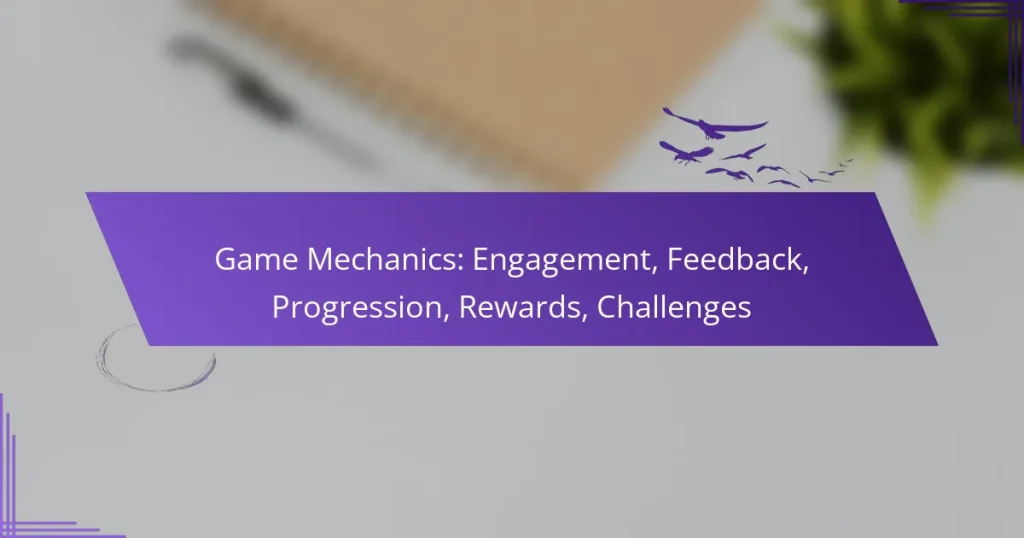Game mechanics play a crucial role in enhancing player engagement by creating interactive experiences that captivate and motivate players. They provide immediate feedback, establish a sense of progression, and offer rewards that encourage continued participation, ultimately enriching the overall gaming experience.

How do game mechanics enhance engagement?
Game mechanics enhance engagement by creating interactive experiences that captivate players and keep them invested in the gameplay. These mechanics provide immediate feedback, establish a sense of progression, and offer rewards that motivate continued participation.
Interactive storytelling
Interactive storytelling immerses players in a narrative where their choices significantly impact the outcome. This mechanic encourages emotional investment, as players feel a personal connection to the story and its characters. Games like “The Walking Dead” series exemplify this, allowing players to make decisions that alter the plot and character relationships.
To effectively implement interactive storytelling, developers should focus on branching narratives and meaningful choices that resonate with players. This can lead to varied experiences and multiple endings, enhancing replayability and engagement.
Dynamic challenges
Dynamic challenges adjust in difficulty based on player performance, keeping the gameplay experience fresh and engaging. This mechanic ensures that players are consistently challenged without becoming frustrated, as the game adapts to their skill level. For instance, games like “Dark Souls” provide tough obstacles while rewarding perseverance.
To create effective dynamic challenges, developers can utilize algorithms that analyze player behavior and adjust difficulty accordingly. This approach not only maintains engagement but also fosters a sense of achievement as players overcome these tailored challenges.
Social interaction features
Social interaction features, such as multiplayer modes and leaderboards, enhance engagement by fostering community and competition among players. These features encourage players to connect, collaborate, or compete, making the gaming experience more enjoyable and dynamic. Games like “Fortnite” leverage social interaction to create a vibrant player community.
Incorporating social elements can be as simple as adding chat functions or as complex as creating guilds or clans. Developers should consider how these features can enhance the overall experience and encourage players to return for social engagement.
Personalization options
Personalization options allow players to tailor their gaming experience to their preferences, increasing engagement by making the game feel more relevant to them. Customization can include character appearances, gameplay styles, or even difficulty settings. Games like “The Sims” thrive on personalization, enabling players to create unique experiences.
To maximize the impact of personalization, developers should offer a variety of options that cater to different player preferences. This can include cosmetic items, skill trees, or gameplay modifiers, ensuring that players feel a sense of ownership over their experience.

What feedback mechanisms improve player experience?
Effective feedback mechanisms enhance player experience by providing timely information, tracking progress, and gathering opinions. These tools help players understand their performance and keep them engaged in the game.
Real-time notifications
Real-time notifications inform players about important events, achievements, or changes within the game. These alerts can include level completions, new challenges, or rewards earned, which keep players engaged and motivated to continue playing.
Implementing a notification system requires careful consideration of timing and frequency to avoid overwhelming players. Notifications should be relevant and timely, ideally appearing within seconds of the event to maintain immersion.
Progress tracking systems
Progress tracking systems allow players to monitor their advancement through the game, providing a sense of accomplishment. These systems can display levels completed, skills acquired, or items collected, helping players set goals and stay motivated.
Effective progress tracking can include visual indicators like bars or charts, as well as numerical stats. It’s important to update this information regularly, ideally in real-time, to keep players informed and engaged.
Player surveys and ratings
Player surveys and ratings collect feedback directly from users about their gaming experience. This input can help developers identify areas for improvement and understand player preferences, ultimately enhancing the overall experience.
Surveys should be concise and focused, ideally taking no more than a few minutes to complete. Offering incentives, such as in-game rewards for participation, can increase response rates and provide more valuable insights.

How does progression work in game design?
Progression in game design refers to the systems that allow players to advance, improve, and unlock new content throughout their gaming experience. Effective progression keeps players engaged by providing clear goals, rewards, and a sense of achievement as they navigate challenges.
Leveling systems
Leveling systems are structured frameworks that allow players to gain experience points (XP) and increase their character’s level. As players accumulate XP, they unlock new abilities, enhance stats, or gain access to advanced areas within the game. A common approach is to set level thresholds that require progressively more XP, creating a sense of accomplishment as players reach higher levels.
When designing a leveling system, consider the balance between challenge and reward. Too easy of a progression can lead to boredom, while overly difficult requirements may frustrate players. Aim for a steady increase in difficulty that keeps players motivated.
Skill trees
Skill trees provide players with a visual representation of their character’s abilities and potential upgrades. Players can choose specific paths within the tree, allowing for personalized gameplay experiences. This system encourages strategic thinking, as players must decide which skills to prioritize based on their play style.
To create an effective skill tree, ensure that each branch offers meaningful choices and that skills complement one another. Avoid overwhelming players with too many options at once; instead, introduce new skills gradually as they progress through the game.
Unlockable content
Unlockable content includes additional features, characters, or items that players can access after meeting certain criteria, such as completing missions or achieving specific milestones. This system enhances replayability and encourages players to explore different aspects of the game.
When implementing unlockable content, consider offering a mix of both essential and cosmetic items. This approach allows players to feel a sense of achievement while also providing opportunities for customization. Clear communication about how to unlock content is crucial to maintain player interest and engagement.

What types of rewards motivate players?
Players are motivated by various types of rewards that enhance their gaming experience and encourage continued engagement. These rewards can include in-game currency, exclusive items, and achievements that provide a sense of accomplishment.
In-game currency
In-game currency serves as a primary motivator for players, allowing them to purchase items, upgrades, or services within the game. Players often feel a sense of progression as they accumulate currency, which can be earned through gameplay, completing quests, or winning battles.
Common examples of in-game currency include coins, gems, or tokens, which can vary widely in value and utility depending on the game. Developers should consider balancing the earning potential and spending options to maintain player interest and avoid frustration.
Exclusive items
Exclusive items are unique rewards that players can obtain, often through special events, achievements, or in-game purchases. These items can range from rare weapons to custom skins, and they often enhance gameplay or provide aesthetic appeal.
Offering exclusive items can create a sense of urgency and competition among players, motivating them to engage more deeply with the game. However, it is crucial to ensure that these items do not disrupt game balance or create pay-to-win scenarios.
Achievements and badges
Achievements and badges are recognition systems that reward players for reaching specific milestones or completing challenges. These rewards can enhance player satisfaction and encourage them to explore different aspects of the game.
Implementing a variety of achievements can cater to different player styles, from casual gamers to hardcore enthusiasts. Developers should ensure that achievements are attainable yet challenging, providing a balanced sense of accomplishment without overwhelming players.

What challenges keep players engaged?
Challenges that keep players engaged often involve time constraints, varying difficulty levels, and competitive elements. These aspects create a dynamic environment where players feel motivated to improve their skills and achieve goals.
Timed events
Timed events are challenges that require players to complete tasks within a specific timeframe. These events can create a sense of urgency and excitement, encouraging players to participate actively. For example, a game might host a weekend event where players must gather resources or defeat enemies before the clock runs out.
To maximize engagement, ensure that the time limits are reasonable, allowing players to strategize without feeling overwhelmed. Offering unique rewards for completing timed events can further incentivize participation.
Difficulty scaling
Difficulty scaling adjusts the challenge level based on player performance, ensuring that the game remains engaging for both novices and veterans. This can involve increasing enemy strength, introducing new mechanics, or adding obstacles as players progress. For instance, a game might start with easy levels and gradually introduce more complex puzzles or tougher opponents.
It’s crucial to find a balance; if the difficulty increases too quickly, players may feel frustrated and disengage. Regularly gathering player feedback can help fine-tune the scaling process to maintain interest and challenge.
Competitive leaderboards
Competitive leaderboards rank players based on their performance, fostering a sense of competition and community. Players are motivated to improve their scores or complete challenges faster to climb the ranks. For example, a racing game might display the fastest lap times, encouraging players to beat their friends’ records.
To enhance engagement, consider implementing seasonal resets or special events that refresh the leaderboard. This keeps the competition lively and encourages players to return frequently to prove their skills.

What are the prerequisites for effective game mechanics?
Effective game mechanics require a clear understanding of player engagement, feedback systems, progression paths, rewards, and challenges. These elements must work together cohesively to create an enjoyable and motivating gaming experience.
Engagement
Engagement in games is driven by how well the mechanics capture and maintain player interest. Key factors include immersive storylines, interactive gameplay, and social elements that encourage player interaction. Games should offer a balance of challenge and skill to keep players invested.
To enhance engagement, developers can implement features like dynamic environments, character customization, and community events. Regular updates and new content can also sustain interest over time, ensuring players remain connected to the game.
Feedback
Feedback is crucial for informing players about their performance and guiding their decisions. Effective feedback can be visual, auditory, or tactile, providing immediate responses to player actions. This helps players understand the consequences of their choices and encourages them to improve.
Incorporating clear indicators of success or failure, such as scoreboards or achievement notifications, can enhance the gaming experience. Developers should ensure that feedback is timely and relevant, avoiding overwhelming players with excessive information.
Progression
Progression mechanics allow players to advance through levels, unlock new content, or enhance their skills. A well-structured progression system keeps players motivated by providing a sense of accomplishment and clear goals. This can be achieved through leveling up, skill trees, or unlocking new characters and abilities.
To maintain player interest, progression should be paced appropriately, with a mix of short-term and long-term goals. Developers should avoid making progression feel tedious, ensuring that rewards are meaningful and that players can see their growth over time.
Rewards
Rewards are essential for reinforcing positive behavior and encouraging continued play. These can include in-game currency, items, or achievements that enhance the player’s experience. A well-designed reward system can significantly boost player motivation and satisfaction.
Developers should consider varying the types of rewards to cater to different player preferences. For example, some players may value cosmetic items, while others may prioritize gameplay advantages. Offering both types can appeal to a broader audience.
Challenges
Challenges are integral to keeping gameplay exciting and stimulating. They should be designed to test players’ skills without causing frustration. A good challenge provides a sense of risk and reward, pushing players to improve while ensuring that success is attainable.
To create effective challenges, developers can implement varying difficulty levels, time limits, or unique objectives. It’s important to balance challenges so that they are neither too easy nor too difficult, allowing players to feel a sense of achievement when they overcome obstacles.


